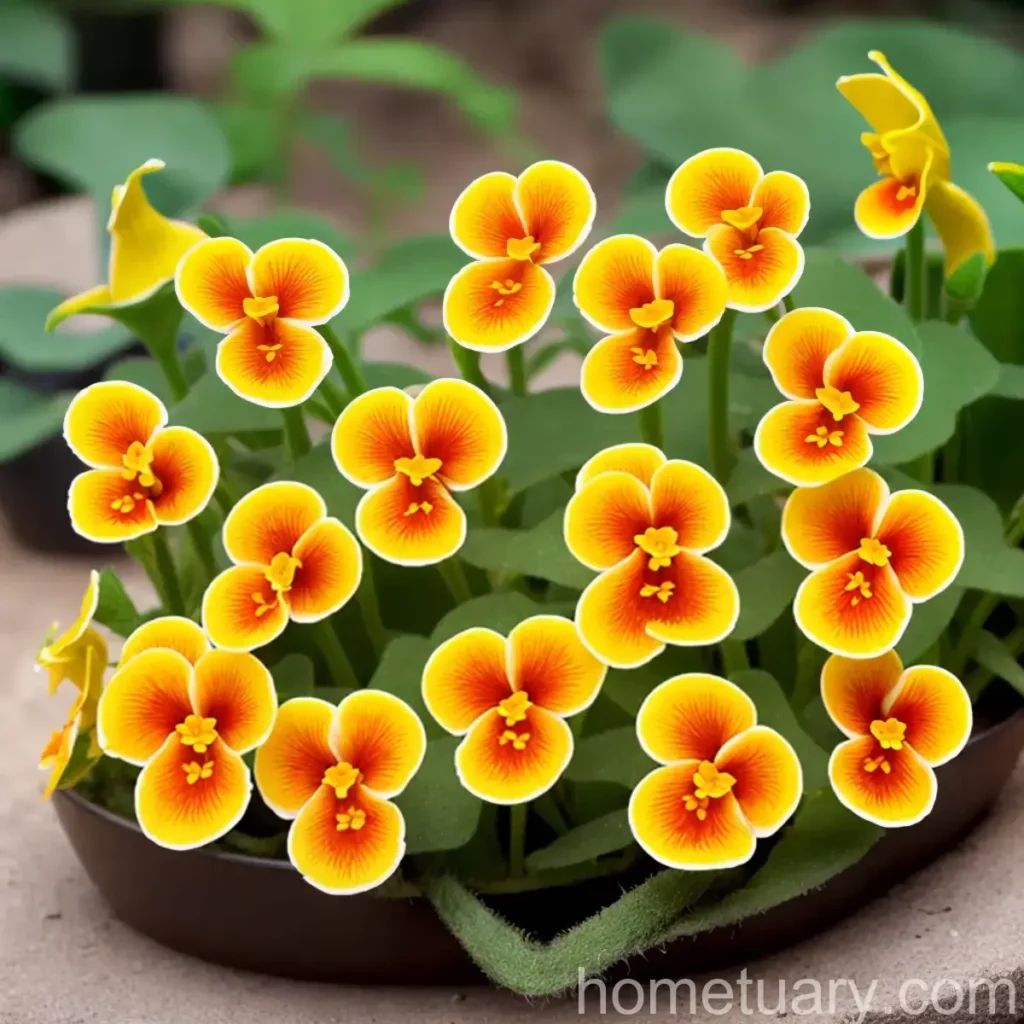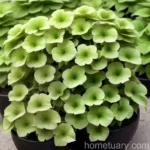Slipper Flower (Calceolaria (Herbeohybrida Group))
Slipper flowers, scientifically known as Calceolaria (Herbeohybrida Group), are distinguished by their unique slipper-shaped blossoms. These delightful flowering plants originate from South America and make for a striking addition to gardens, containers, and indoor spaces.
In this comprehensive guide, we will delve into the various aspects of slipper flower care, including its cultivation, uses, growing conditions, common diseases, and pest management. Whether you are a seasoned plant enthusiast or a beginner looking to nurture these charming blooms, this article will equip you with the knowledge needed to foster healthy and vibrant slipper flowers.
What is a Slipper Flower?
The slipper flower, a member of the Calceolaria (Herbeohybrida Group) genus, encompasses a diverse range of plant species and hybrids. Their name is derived from the unique shape of their flowers, which closely resemble miniature, ornate slippers. These blooms are typically brightly colored and often feature intricate patterns, adding a touch of whimsy to any environment they grace.
Key Takeaways
Before we delve deeper into the specifics of caring for slipper flowers, let’s outline the key takeaways when it comes to nurturing these enchanting plants:
- Plant Name: Slipper Flower (Calceolaria (Herbeohybrida Group))
- USDA Hardiness Zones: Generally zones 8 to 10
- Watering: Moderate; avoid waterlogged conditions
- Sunlight: Bright, indirect light
- Fertilization: Balanced liquid fertilizer every 2-4 weeks during the growing season
- Soil: Well-draining, slightly acidic soil mix
- Pruning: Remove spent flowers; minimal pruning during active growth
- Propagation: Typically from seed or stem cuttings
- Container Use: Well-suited for containers and hanging baskets
- Popularity: Often grown for its unique flowers
- Common Diseases: Watch for powdery mildew and botrytis
- Common Pests: Keep an eye out for aphids and whiteflies
Now, let’s explore these key aspects of slipper flower care in greater detail.
Culture
Cultivating slipper flowers involves paying careful attention to their specific requirements, which encompass various factors such as water, sunlight, soil, and fertilizer. Understanding the cultural needs of these plants is fundamental to their overall health and vitality.
Water
Proper watering is essential for the well-being of slipper flowers. These plants generally prefer consistently moist but not waterlogged soil. Inadequate watering may lead to wilting and diminished flower production, while excessive moisture can result in root rot and other complications.
- Watering Frequency: Ensure that the soil is kept evenly moist, particularly during the active growth period.
- Soil Moisture: Aim to keep the soil consistently moist, but not saturated. Allow the top layer of soil to dry out slightly before watering again.
Sunlight
Ideal lighting conditions play a crucial role in the growth and flowering of slipper plants. Providing adequate sunlight ensures robust growth and vibrant blooms.
- Light Requirements: Slipper flowers thrive in bright, indirect light. Shield them from harsh, direct sunlight, especially during the hottest parts of the day.
- Indoor Cultivation: When grown indoors, place slipper flowers near a south- or west-facing window where they can receive ample sunlight. Supplemental lighting may be necessary during the darker months.
Fertilizer
Fertilizing slipper flowers promotes healthy growth and enhances their flowering capacity. However, it is essential to provide the correct type and amount of fertilizer to prevent issues such as fertilizer burn or nutrient imbalances.
- Fertilizer Type: Use a balanced liquid fertilizer formulated for flowering plants to support overall growth and flower development.
- Frequency: Feed slipper flowers every 2-4 weeks during the active growing season, following the manufacturer’s recommended dilution and application guidelines.
- Avoid over-fertilization, as this can lead to excessive vegetative growth at the expense of flowering.
Soil
The choice of soil directly impacts the overall health and vigor of slipper flowers. A well-draining and sufficiently aerated soil mix is crucial for preventing waterlogged conditions and ensuring root health.
- Soil Mix: Opt for a quality potting mix tailored for flowering plants, or create a blend using components such as peat moss, perlite, and compost.
- pH Level: Aim for a slightly acidic soil pH of around 6.0 to 6.5 to promote optimal nutrient uptake and root function.
- Ensure that the chosen soil mix offers good drainage to prevent water accumulation around the roots.
Pruning
Pruning plays a role in maintaining the neat appearance of slipper flowers and can also help promote additional flowering. While these plants generally require minimal pruning, timely removal of spent blooms and the occasional trim can contribute to their overall health and appearance.
- Deadheading: Regularly remove spent flowers to encourage continuous blooming and prevent the plant from expending energy on seed production.
- Minimal Pruning: Avoid excessive pruning, especially during the active growth phase, as this can diminish the plant’s energy reserves and potentially delay flowering.
Propagation
The propagation of slipper flowers can be achieved through various methods, including seed sowing and stem cuttings. Understanding the different propagation techniques allows plant enthusiasts to expand their collection of slipper flowers and share these charming plants with others.
Seed Propagation
- Sowing Time: Start sowing slipper flower seeds indoors approximately 10-12 weeks before the last expected frost date in your area.
- Seedling Care: Provide consistent moisture and warmth to encourage successful germination and healthy seedling development.
- Transplanting: Once the seedlings have developed several sets of true leaves, they can be carefully transplanted into individual pots or outdoor garden beds.
Stem Cutting Propagation
- Cutting Selection: Choose healthy, non-flowering stems for propagation, ideally with several leaf nodes along the length of the cutting.
- Rooting Medium: Dip the cut end of the stem in a rooting hormone and place it in a well-draining rooting medium, such as a mix of perlite and peat.
- Rooting Conditions: Provide warmth and consistent moisture to support the development of roots. Once roots have formed, the new plantlets can be potted into individual containers.
Container Popularity
Slipper flowers are well-suited for container gardening, offering a compact and visually captivating addition to outdoor and indoor spaces alike. Their charming blooms and relatively small size make them an excellent choice for those looking to adorn their patios, balconies, or indoor environments with a touch of floral elegance.
- Container Selection: Choose pots or containers with adequate drainage holes to prevent waterlogging and promote healthy root growth.
- Indoor Display: Cultivate slipper flowers in decorative containers to showcase their distinctive flowers and complement interior décor.
- Outdoor Accents: Place potted slipper plants on patios, verandas, or garden nooks to add a splash of color and visual interest.
Common Diseases
As with any plant, slipper flowers are susceptible to certain diseases that can hinder their growth and overall health. Understanding these potential ailments and proactive disease prevention measures is crucial for maintaining robust, disease-resistant plants.
Disease Diagnosis
- Powdery Mildew: Watch for the development of powdery, white fungal growth on the leaves and stems, often accompanied by leaf distortion and yellowing.
- Botrytis: Monitor for signs of gray mold on the leaves and flowers, particularly in humid or poorly ventilated environments.
Common Pests
Pest infestations can pose a threat to the well-being of slipper flowers, impacting their vitality and overall aesthetic appeal. Early detection and appropriate pest management techniques are essential for keeping these charming plants free from harmful insect intruders.
Botanist’s Tips for Pest Control
- Aphids: Keep an eye out for clusters of small, soft-bodied insects on the undersides of leaves and stems. Use a strong spray of water or insecticidal soap to dislodge and control aphid populations.
- Whiteflies: Look for white, fly-like insects when disturbing the foliage. Employ yellow sticky traps and targeted insecticidal treatments to manage whitefly infestations effectively.
Fun Facts
- Slipper flowers are valued for their unique, slipper-shaped blossoms that come in an array of striking colors and patterns, ranging from solid hues to intricate speckling and mottling.
- In their natural habitat, slipper plants can often be found in elevated areas, such as mountainous regions, where they thrive in cool, moist conditions with well-draining soil.
Links to External Resources
For further insights into slipper flower care, propagation, and cultivation, consider exploring the following external resources:
- Royal Horticultural Society – Calceolaria
- University of Minnesota Extension – Growing Annual Flowers
- The American Phytopathological Society – Plant Disease Management
With this comprehensive guide to slipper flower care, you are well-equipped to nurture these captivating plants with confidence and expertise. By paying close attention to their cultural needs, promptly addressing any potential issues, and celebrating their unique charm, you can foster flourishing slipper flowers that bring joy and beauty to your garden, home, or outdoor living spaces.















